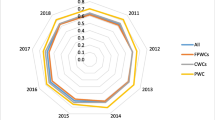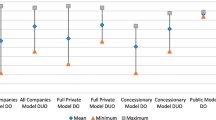Abstract
Providing secure and affordable drinking water and sewerage services is the primary mandate of the urban water industry. Water businesses must balance their service obligations and the quality of service delivered in order to maximize customer value. Being a monopoly industry, the urban water sector’s service levels and associated prices are not driven by competitive market pressures but through the regulatory processes. However, improving service quality often comes at a cost and yardstick regulation requires the evaluation and benchmarking of service quality within an economic efficiency framework. This paper uses a bootstrap Data Envelopment Analysis model to evaluate the service quality performance of the Australian urban water sector from 2009–2010 to 2015–2016. Specifically, the paper models the lack of service quality as undesirable outputs of water production. It estimates the Malmquist-Luenberger productivity index and its efficiency change and technical change components for 50 integrated water and sewerage utilities in Australia. Findings indicate that, overall, the sector’s quality-adjusted productivity has improved after a marked decline in 2010/2011. A comparison of the service quality productivity results with the conventional productivity measure revealed that the conventional analysis tends to underestimate the productivity growth. The paper concludes that benchmarking service quality helps the urban water sector to move from compliance-based regulation to best-practice regulation.








Similar content being viewed by others
Notes
Economists define productivity as the relationship between the output and inputs necessary to produce the output, denoting the efficiency in the use of productive factors (Antle and Capalbo 1988).
The ownership structure ranges from state-owned corporations to divisions in local councils.
Since we are analyzing the global ML index, a bootstrap sample including each DMU and each year is needed to obtain a bootstrap sample of the global technology.
Some small water utilities owned by local councils do not have formal independent price regulation (Worthington and Higgs, 2014).
The National Performance Reporting dataset was initially managed by the National Water Commission, which was abolished in 2014. Thereafter the responsibility of collecting and maintaining the NPR reporting framework was bestowed upon the Bureau of Meteorology. The dataset originates from a single report.
Integrated utilities carry out both water supply and wastewater functions.
The NPR Framework covers the water utilities serving more than 10,000 customers only. There are many water and wastewater service providers, mostly run by local councils that are not included in the NPR framework. Hence, the present study excludes these small water and wastewater providers due to unavailability of data. Out of the 86 existing water utilities that report to the NPR, 36 utilities were dropped due to (a) missing data and (b) not integrated utilities (water only or wastewater only service providers).
Based on the average annual residential water consumption. The alternative is to use average tariff growth. Doing so would, however, result in comparability issues given the significant variation in the fixed and variable step usage charge/s adopted by water utilities throughout Australia (see Crase et al. 2015).
It should be noted that Cunningham (2014) used data from 2006-2013.
Utilities are classified according to the number of customers they serve. For example, the Major 100 K + category covers urban water utilities that serve more than 100,000 customers.
References
Abbott M, Cohen B (2009) Productivity and efficiency in the water industry. Uti Policy 17:233–244
ACIL Tasman Pty Ltd. (2007) Size and Scope Economies in Water and Wastewater Services, An investigation into economies of size and scope associated with alternative structures for the Water Corporation’s activities Prepared for the Economic Regulation Authority. ACIL Tasman Pty Ltd, Melbourne
Ananda J (2013) Evaluating the performance of urban water utilities: robust nonparametric approach. J Water Resour Plan Manag 140:04014021
Berg S, Marques RC (2011) Quantitative studies of water and sanitation utilities: a benchmarking literature survey. Water Policy 13:591–606
Bevan G, Hood C (2006) What’s measured is what matters: targets and gaming in the English health care system. Public Adm 84:517–538
Bureau of Meteorology (2017) National performance report 2015-16: urban water utilities. Bureau of Meteorology, Melbourne
Byrnes J (2013) A short institutional and regulatory history of the Australian urban water sector. Uti Policy 24:11–19
Calabrese A (2012) Service productivity and service quality: a necessary trade-off? Int J Prod Econ 135:800–812
Caves DW, Christensen LR, Diewert E (1982) The economic theory of index numbers and the measurement of input, output and productivity. Econometrica 501:1393–1414
Chung YH et al. (1997) Productivity and undesirable outputs: A directional distance function approach. J Environ Manage 51:229–240
Cooper B, Crase L, Pawsey N (2014) Best practice pricing principles and the politics of water pricing. Agric Water Manag 145:92–97
Crase L, Pawsey N, Cooper B (2015) Water pricing in Australia: unbundled politics, accounting and water pricing. In Dinar A, Pochat V, Albiac J (Eds.). Water pricing experiences and innovations. Cham, Springer Publications, 15–39
Cunningham M (2014) Victorian urban water utility benchmarking. Report prepared for the Essential Services Commission, Melbourne
Destandau F, Garcia S (2014) Service quality, scale economies and ownership: an econometric analysis of water supply costs. J Regul Econ 46:152–182
Durdyev S, Ihtiyar A, Ismail S, Ahmad FS, Bakar NA (2014) Productivity and service quality: factors affecting in service industry. Procedia Social Behav Sci 109:487–491
Ehrhardt D, Groom E, Halpern J, O’Connor S (2007). Economic regulation of urban water and sanitation services: some practical lessons, Water Sector Board Discussion Paper Series: Paper No. 9. The World Bank, Washington, DC
ESC (2008) Water price review 2008. https://www.esc.vic.gov.au/water/water-prices-tariffs-andspecial-drainage/water-price-reviews/water-price-review-2008
ESC (2009) Metropolitan water price review 2009. http://www.esc.vic.gov.au/metropolitan-water-pricereview-2009
ESC (2013) Water price review 2013. https://www.esc.vic.gov.au/water/water-prices-tariffs-and-specialdrainage/water-price-reviews/water-price-review-2013
ESC (2018) Water price review 2018. https://www.esc.vic.gov.au/water/water-prices-tariffs-and-specialdrainage/water-price-reviews/water-price-review-2018
Färe R (2010) Directional distance functions and public transportations: a comment. Transp Res Part D 15:108–109
Färe R, Grosskopf S (2003) Nonparametric productivity analysis with undesirable outputs: comment. Am J Agric Econ 85:1070–1074
Färe R, Grosskopf S, Lindgren B, Roos P (1992) Productivity changes in Swedish pharmacies 1980-1989: a non-parametric Malmquist approach. J Product Anal 3:85–101
Färe R, Grosskopf S, Pasuka Jr CA (2001) Accounting for air pollution emissions in measures of state manufacturing productivity growth. J Reg Sci 41:381–409
Färe R, Primont D (1995) Multi-output production and duality: theory and applications. Kluwer Academic Publishers, Dordrecht
Farrell MJ (1957) The measurement of productive efficiency. J R Stat Soc 120:253–281
Frontier Economics (2014) Improving economic regulation of urban water: a report prepared for the Water Services Association of Australia. Frontier Economics Pty. Ltd., Melbourne
Golder PN, Mitra D, Moorman C (2012) What is quality? An integrative framework of processes and states. J Mark 76:1–23
IPART (2015) Sydney Water Operating Licence 2015–2020. http://www.sydneywater.com.au/SW/about-us/our-organisation/what-we-do/operating-licence/index.htm
IPART (2017) Hunter Water Operating Licence 2017–2022. https://www.hunterwater.com.au/About-Us/Our-Organisation/Governance/Operating-Licence.aspx
Jeon BM, Sickles RC (2004) The role of environmental factors in growth accounting. J Appl Econ 19:567–591
Lin C (2005) Service quality and prospects for benchmarking: evidence from the Peru water sector. Uti Policy 13:230–239
Lin C, Berg SV (2008) Incorporating service quality into yardstick regulation: an application to the Peru Water Sector. Rev Ind Organ 32:53–75
Marques RC (2006) A yardstick competition model for Portuguese water and sewerage services regulation. Uti Policy 14:175–184
Maziotis A, Molinos-Senante M, Sala-Garrido R (2017) Assessing the impact of quality of service on the productivity of water industry: a Malmquist-Luenberger approach for England and Wales. Water Resour Manag 31:2407–2427
McDonald-Kerr L (2017) Water, water, everywhere: using silent accounting to examine accountability for a desalination project. Sustain Account, Manag Policy J 8(1):43–76
Molinos-Senante M, Maziotis A, Mocholí-Arce M, Sala-Garrido R (2016) Accounting for service quality to customers in the efficiency of water companies: evidence from England and Wales. Water Policy 18:513
National Water Commission (2011) Urban water in Australia: future directions. National Water Commission, Canberra
National Water Commission (2013) 2012-13 National Performance Framework: urban performance reporting indicators and definitions handbook. National Water Commission, Canberra
Oh D-h (2010) A global Malmquist-Luenberger productivity index. J Product Anal 34:183–197
Pastor JT, Lovell CAK (2005) A global Malmquist productivity index. Econ Lett 88:266–271
Pawsey N, Ananda J, Hoque Z (2018) Rationality, accounting and benchmarking water businesses: An analysis of measurement challenges. Int J Pub Sector Manage 31:290–315
Picazo-Tadeo AJ, Sáez-Fernández FJ, González-Gómez F (2008) Does service quality matter in measuring the performance of water utilities? Uti Policy 16:30–38
Price WC, Brigham B, Fitzgerald L (2008) Service quality in regulated network industries. Ann Public Coop Econ 79:197–225
Romano G, Molinos-Senante M, Guerrini A (2017) Water utility efficiency assessment in Italy by accounting for service quality: an empirical investigation. Uti Policy 45:97–108
Saal DS, Parker D (2001) Productivity and price performance in the privatised water and sewerage companies of England and Wales. J Regul Econ 20:61–90
Saal DS, Parker D, Weyman-Jones T (2007) Determining the contribution of technical change, efficiency change and scale change to productivity growth in the privatised English and Welsh water and sewerage industry: 1985–2000. J Product Anal 28:127–139
Simar L, Wilson PW (1999) Estimating and bootstrapping Malmquist indices. Eur J Oper Res 115:459–471
Simar L, Wilson PW (2008) Statistical inference in nonparametric frontier models: recent developments and perspectives. In: Fried HO, Lovell CAK, Schmidt SS (Eds) The measurement of productive efficiency and productivity growth. Oxford University Press, Oxford, p 421–521
Tupper HC, Resende M (2004) Efficiency and regulatory issues in the Brazilian water and sewage sector: An empirical study. Utilities Policy 12:29–40
Woodbury K, Dollery BE (2004) Efficiency measurement in Australian local government: the case of New South Wales municipal water services. Rev Policy Res 21:615–636
Worthington AC (2014) A review of frontier approaches to efficiency and productivity measurement in urban water utilities. Urban Water J 11:55–73
Yörük BK, Zaim O (2005) Productivity growth in OECD countries: a comparison with Malmquist indices. J Comp Econ 33:401–420
Zhang C, Liu H, Bressers HTA, Buchanan KS (2011) Productivity growth and environmental regulations - accounting for undesirable outputs: analysis of China’s thirty provincial regions using the Malmquist-Luenberger index. Ecol Econ 70:2369–2379
Author information
Authors and Affiliations
Corresponding author
Ethics declarations
Conflict of interest
The authors declare that they have no conflict of interest.
Additional information
Publisher’s note: Springer Nature remains neutral with regard to jurisdictional claims in published maps and institutional affiliations.
Rights and permissions
About this article
Cite this article
Ananda, J., Pawsey, N. Benchmarking service quality in the urban water industry. J Prod Anal 51, 55–72 (2019). https://doi.org/10.1007/s11123-019-00545-w
Published:
Issue Date:
DOI: https://doi.org/10.1007/s11123-019-00545-w
Keywords
- Water utilities
- Service productivity
- Undesirable outputs
- Malmquist-Luenberger index
- Data envelopment analysis
- Directional distance functions





